The New Gastronome
Third Wave or Not
Specialty Coffee Fermentation and Farming
by Saar Avrashi
by Saar Avrashi
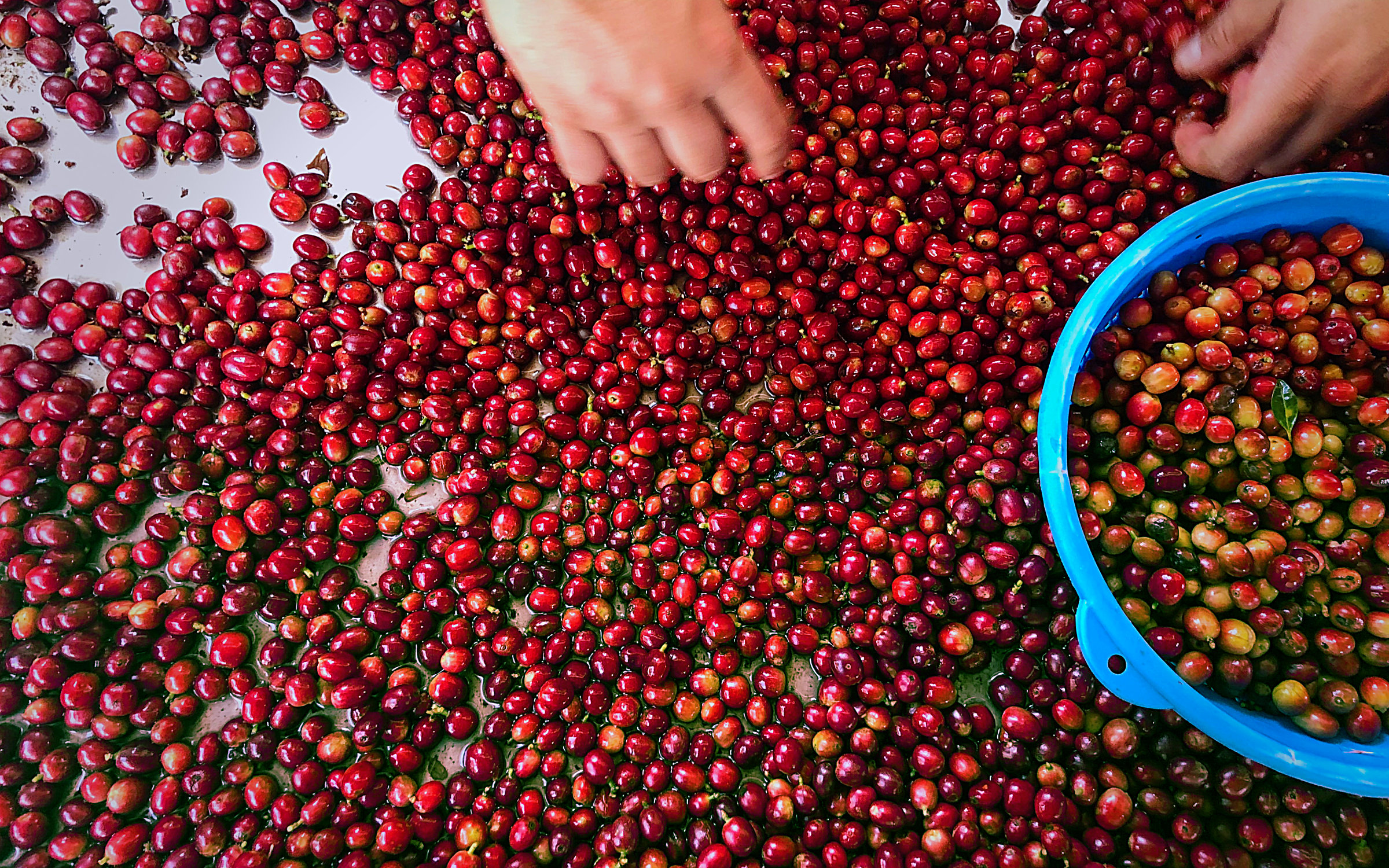
Coffee processing, or rather, coffee fermentation methods are becoming the trendiest topic among coffee aficionados, whether we talk about “third wave” or not. And, it seems this topic will not disappear anytime soon since this particular phase of coffee production is quite under-developed and relatively modern – especially when compared to its big brother and role model of sorts, wine.
Before diving deeper into the magical world of coffee processing, one myth has to be debunked: Coffee is not necessarily a fermented product! For a coffee farmer, who is aiming to reach the specialty coffee market, fermentation becomes almost mandatory but, in the case of commodity coffee, the vast majority of different coffees doesn’t undergo any “intended” fermentation. Strictly speaking, though, any fruit starts fermenting from the moment it’s picked from the tree.
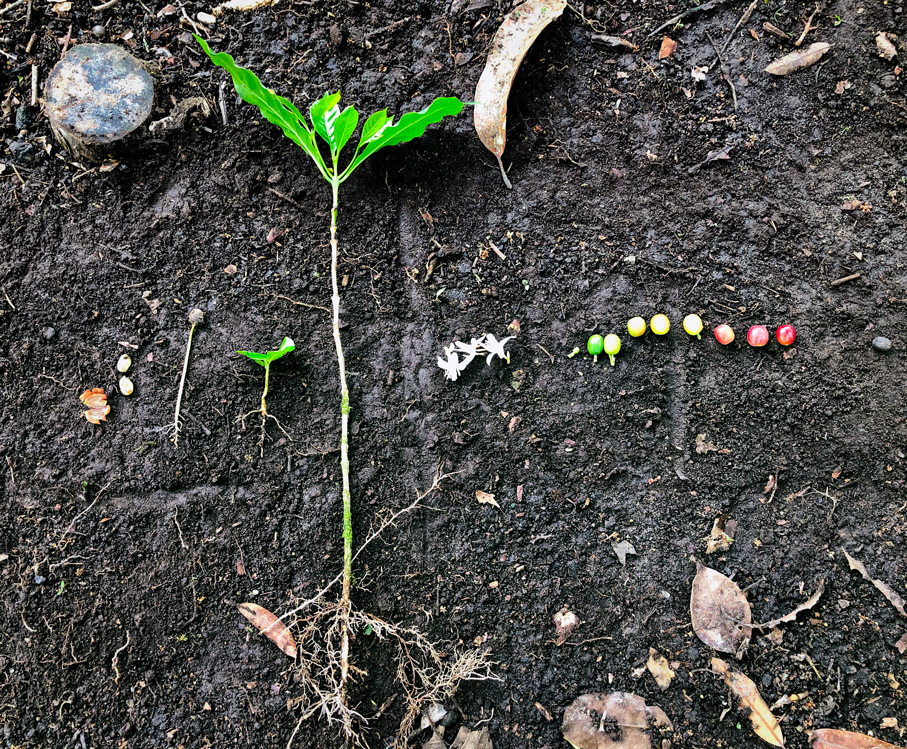 Coffee bean cycle.
Coffee bean cycle.
You might wonder why specialty coffee producers are “almost” obliged to ferment their coffee. Fermentation is not an official requirement by the SCA – the Specialty Coffee Association – but for coffee to be considered a “speciality”, it must reach a grade of 80 points or more, given by the quality graders of the SCA. Those that manage to reach 90 points or more are considered exceptional. The points are appointed after a formalised session by the SCA, based on a multi-sensorial tasting, including aroma, fragrance, taste, flavour and aftertaste. In order to reach the 80+ threshold, coffee must obtain certain levels of complexity. Therefore, the more richness and distinct tasting notes a coffee has, the higher the score will be. And that’s where fermentation comes into play: without fermentation, the chances of coffee beans carrying this glorious complexity are quite low.
Fermentation in coffee is an interaction between the many microorganisms, like yeasts and bacteria, in and around the cherries and the sugars which exist within the mucilage, the sticky layer between the seed and the pulp. The microbes break down the sugars of the fruit and quickly lead to chemical and biological changes in the beans, which, in turn, generate a lovely complexity and depth of flavours.
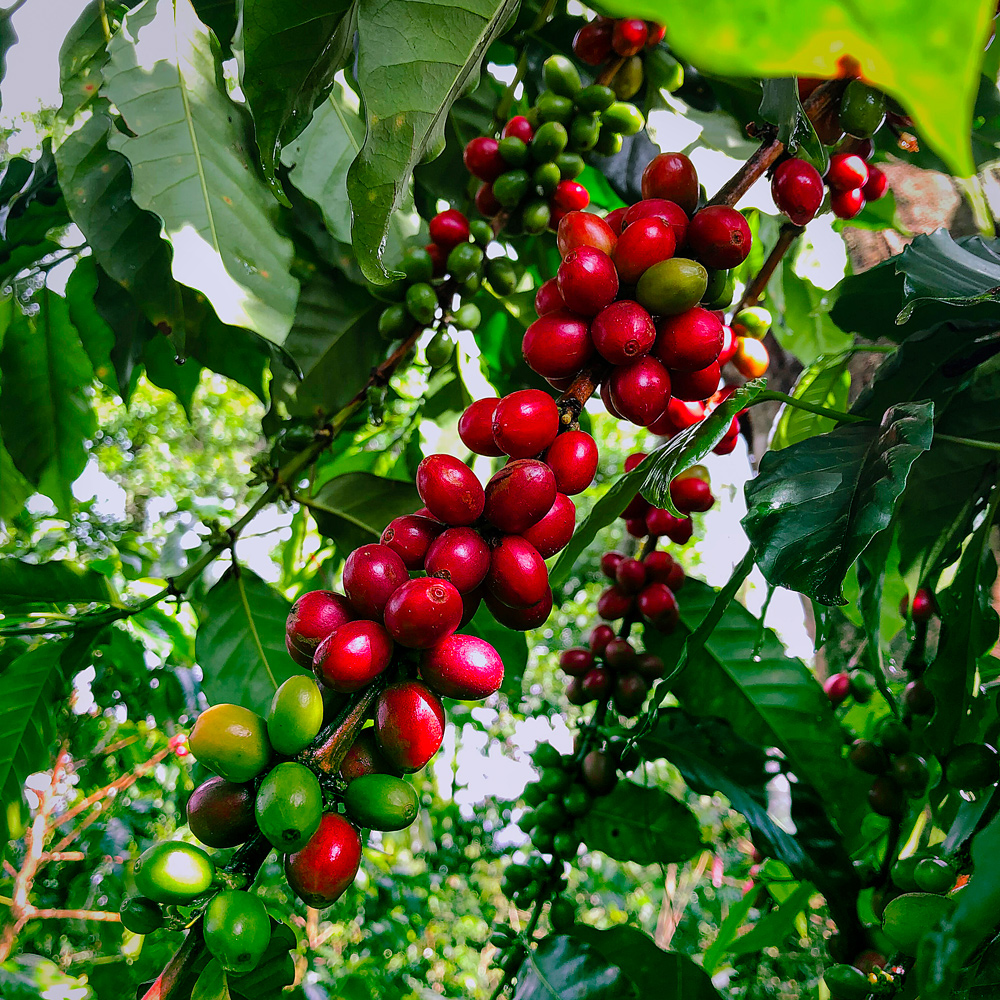 Ripe coffee cherries.
Ripe coffee cherries.
Putting the Special into Specialty
I was lucky enough to join Jesus Armando Bedoya, a Colombian coffee producer from the region of Quindío, for more than two months of an intense, unofficial coffee ‘internship’. Bedoya is a very unique coffee producer – even on global scales – since he operates the whole coffee value chain at Cafè Jesus Martin. His family has been growing coffee for four generations, but he also processes, roasts, packs, labels and serves his coffee directly in Salento, Colombia.
Most farmers around the world sell their coffee to cooperatives that collect the product from many different places, or, in the best case, they sell them directly to the coffee buyer/roaster. Instead, Jesus is trying to break the rules of the coffee game by keeping his best produce within origin, in order to serve it to Colombians. As the higher quality coffee is usually exported to the international market, they are the ones stuck drinking low-grade coffee (called pasilla in Spanish). This decision wasn’t simple for Jesus, as he is the only one out of five siblings, who has decided to cultivate specialty coffee, contrary to his father and his grandfather. In the beginning, his father, Noel Bedoya, was sceptical, as it was an unusual choice, but from the moment he had the opportunity to try his son’s coffee, he understood that Jesus was doing the right thing.
For my personal experience, it was great that Jesus focuses on the entire supply chain, as I had the opportunity to be directly involved in every step of the coffee production, from harvest to coffee making and everything in-between. I particularly liked, and subsequently spent most time at the benificio, the so-called ‘wet-mill’. As I find this term quite imprecise in English, the benificio, in simple terms, is the processing centre of the farm, where all coffee pickers drop their collected fruits off. Immediately after weighing the coffee cherries, the coffee begins its processing stage. In the benificio of Jesus’ farm ‘Finca Buenos Aires’, I worked with Hugo, nicknamed El Capitan, who, under the supervision of Jesus, is responsible for all the fermentation activities at the farm and is helped by Juan and Estefania, who usually work in coffee sorting.
Coffee to Coffee: Fermentation Processes
In the case of Café Jesus Martin, all cherries are soaked in a lot of water and the floating ones (flotadores in Spanish) are taken to be used for pasilla coffee. Afterwards, a long and intensive manual sorting begins, performed mainly by Estefania and aimed to keep only the ripest and reddest cherries. From there, the next step is a decision that has to be made by the owner of the farm and that depends on many variables: which type of fermentation should the coffee undergo?
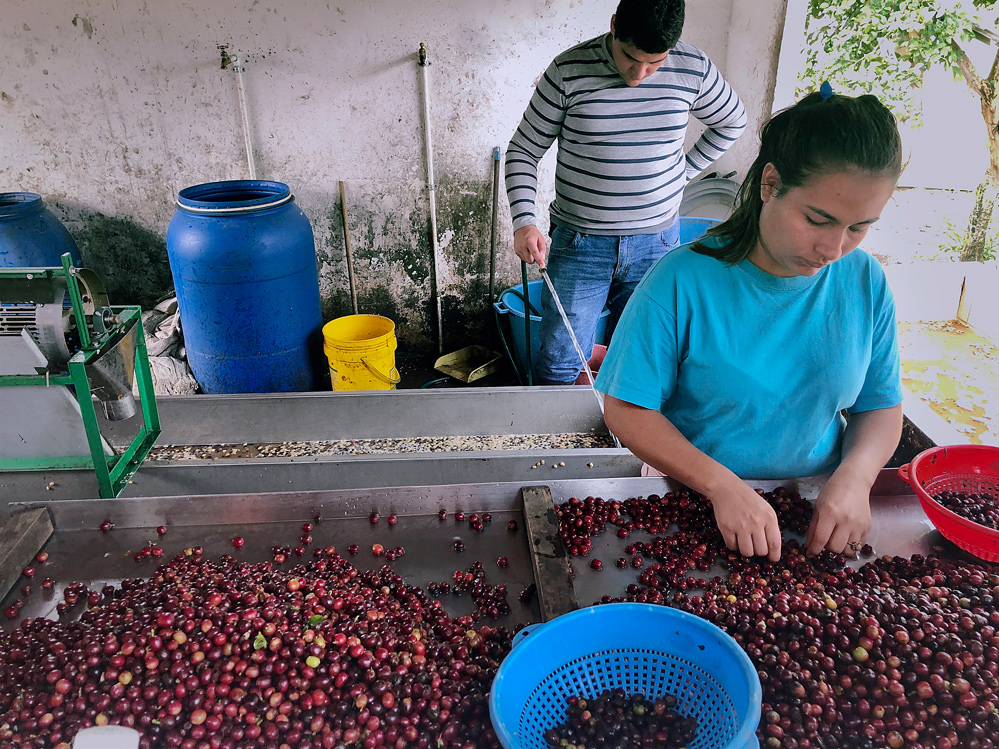 Stefania & Henry.
Stefania & Henry.
The weather conditions are considered just as much as the demand in shops, the amount of time during that specific working day, the quality of the beans and many more. If I had to single out one, most important, factor for the decision, I would probably choose the ripeness of the cherries. If they are at their perfect ripeness, 100% deep red in colour, they would usually be sent to start fermentation and later to dry in the greenhouse at their natural state – skin on. In professional terminology, they would undergo natural fermentation.
Naturally fermented coffee has rightfully earned the reputation of giving a sweeter cup, with chocolatey or nutty notes and a heavier body. The reason for that is quite simple: all of the sugar in the fruit is contained in the mucilage and the pulp. So, when the coffee is fermented with the skin, we keep 100% of its sugar content. However, this type of fermentation has two main disadvantages: 1) since the bean is covered with more layers, fermentation and drying take a lot longer, 2) it’s much harder to control. In tropical areas, the climate is usually unstable and consistent hours of good sunlight, specifically during harvest time, are not always guaranteed. If drying is inconsistent, there is no way of knowing what exactly is going on inside the fruit.
Like many of the choices made in coffee production, whether to natural ferment coffee or not is, in reality, a matter of microclimate and culture. Regions with consistent hours of sun and a tradition of fermenting naturally, like Ethiopia for instance, will usually choose this type of processing.
The next type of fermentation, which is actually the most commonly used worldwide, is wet fermentation, also called washed process. In the wet fermentation of Café Jesus Martin, after the red cherries are sorted, the coffee is immediately de-pulped, meaning that the skin of the fruit is mechanically taken away. Afterwards, the beans will be left to ferment inside a sealed tank for at least 18 hours. Once the pH levels have dropped to around 3.7 and the fermentation process is complete, the sticky fermented beans will be thoroughly washed. Each producer can decide how to wash-process their coffee, but the one thing that determines whether coffee is washed or not is the presence of the mucilage. If the mucilage is completely taken off, the coffee has been wash-processed. All other variables are completely up to the producer’s preference.
Washed coffee is known to have a clean cup profile, which usually possesses notes of citrus and crispy fruits, a juicy mouthfeel and a general sensation of brightness. Kenya and Colombia are both very good examples of origins that have beautiful washed coffees.
The third most common fermentation method is called the honey process. It got its name due to the sticky honey-like mucilage layer that can be found between the bean and the skin of the cherry. It’s where most of the sugars are, so naturally, it’s also a crucial part of the fermentation process. At Café Jesus Martin, they keep the cherries to ferment inside tanks as whole fruits. Depending on the honey protocol, after multiple hours they take the cherries out of the tanks and de-pulp them. To differentiate this process from the wet process, the cherries won’t be washed but will be sent immediately to dry in the greenhouse, with the mucilage still attached to the bean. Usually, water is not involved in the honey process whatsoever, although there are different levels of honey processes. These levels are determined by the sugar content and sometimes when classified as ‘semi-washed’, there might actually be some water at play, but at a much lower quantity compared to the wet process. Because the ‘semi-washed’ process doesn’t involve as much water, some of the mucilage is still attached to the bean, allowing the coffee to be still categorized as honey fermented.
In their cup profile, honey coffees are usually somewhere between natural and washed ones: they are higher in acidity than natural coffees, but with a thinner body and hints of sweetness are definitely more present than in washed coffees. In general, honey coffees are considered quite balanced and round.
There are also many other types of processes, some of them are significantly different than the previously mentioned ones, while others are just small variations of them.
I’m Coffee, Cáscara Coffee
Another process worth sharing is a process I invented. I will call it ‘invented’ because I’ve never heard of this kind of process before. It was probably born in my subconscious long before I arrived in Colombia. Already during my time at university, I found out that the skin of the coffee cherry, among coffee aficionados commonly called cáscara (skin in Spanish), is sometimes used to make infusions after it has been dried. This use of the cáscara has followed me for years, as it was brought up again during a course on circular economy. Circularity follows the concept of minimizing waste and continuing to use resources, following the concept of the three Rs: reuse, recycle and reduce. The way cáscara is used in the infusion sets an almost perfect example of a circular approach since it is usually thrown away to rot somewhere in most farms. A compost based on cáscara has an enormous oxygen demand and will never ferment or decompose properly without constant airing.
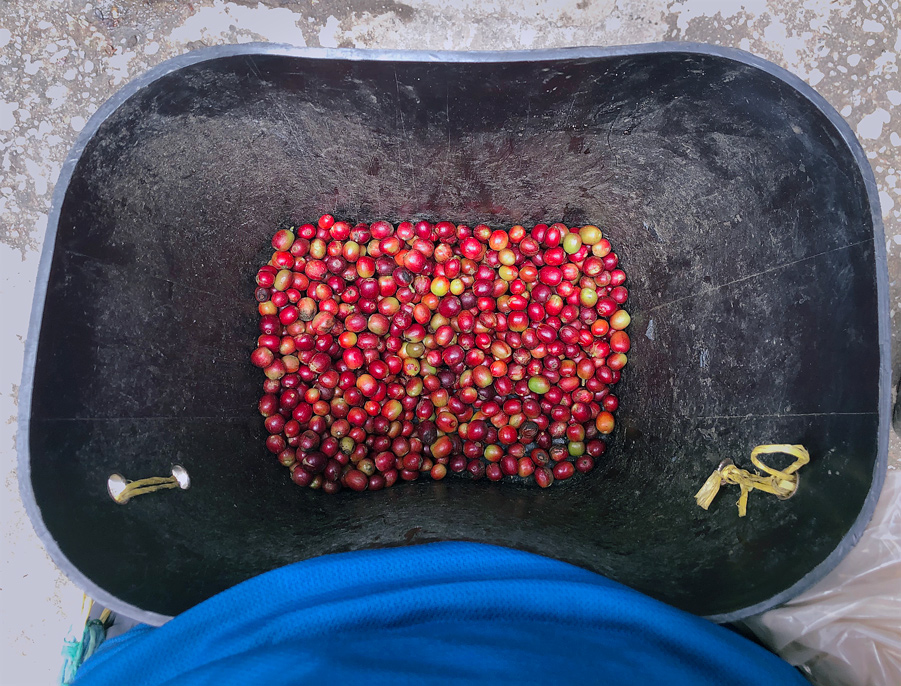 My harvest!
My harvest!
These are precisely the factors that made me think of the cáscara fermentation for Cafè Jesus Martin. After de-pulping the coffee, I kept the clean cáscara aside, soaked it with a lot of cold water and let the beans soak inside this cáscara infusion in a fermentation tank. I decided to take a by-product, usually considered waste, and used it as an instrument to improve fermentation and to provide a wider spectrum of taste notes. After 24 hours of fermentation in this cáscara infusion, I strained the radically-smelling content of the tank and dried both, the beans and the cáscara, to further use the dried cáscara as a locally grown infusion. The scent was highly fermented, almost like warm vinegar. I was a bit worried but still remained positive. After a few days of drying in the greenhouse, the smell of the beans was completely stabilized. As expected at first, the taste notes of the roasted beans were, indeed, unique and outstanding, very floral, juicy and light. The taste of the skin in the fermentation was evident, but in a very different way than one would find them in natural coffees. The contact with the skin also enhanced the mouthfeel, which was juicy but silky at the same time. Out of around ten people, who tried four of my processes, around six to seven said that the cáscara fermentation was the most special one. Jesus and the team were so excited and impressed by this method that they even promised me to adopt it for their own coffee one day. I’m already dreaming about the day when they do!
Photos © Saar Avrashi